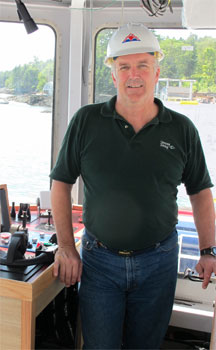The folks at Washburn & Doughty are proud to have built tugboats designed by some of the premier naval architectural firms in North America.
For example, in 2011 the Maine shipyard delivered Hercules, a 98-foot, 6,300-hp escort and docking tug designed by Robert Allan Ltd. in Vancouver, British Columbia, for Suderman & Young. The tug serves LNG tankers calling at Lake Charles, La.
More recently, W&D completed construction of Mark Moran, an 86-foot, 5,100-hp z-drive designed by Jensen Maritime Consultants in Seattle. Earlier this year, the tug began doing ship-assist work in Baltimore.
However, unlike other yards, most of the tugs W&D builds are designed in-house, by the company’s executive vice president, Bruce D. Washburn.
“We have no qualms building other people’s designs,” Washburn said. But he noted that more than three-quarters of the boats his company builds in its East Boothbay yard are W&D’s own proprietary designs.
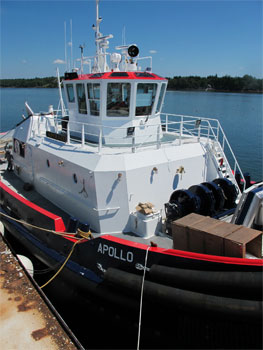 |
|
Seabulk Towing’s 93-foot Apollo. |
The son of a naval architect, Washburn grew up in southern New England, surrounded by boats. His father worked for a company that designed and built deck gear for sailboats and workboats. So not surprisingly, when Washburn came of age, he headed off to the University of Michigan, where in 1974 he was awarded a degree in naval architecture. He has been designing vessels ever since.
Washburn is a down-to-earth kind of guy who talks respectfully of the work done by design firms like Robert Allan and Jensen whose names are admired around the world. At the same time, he is proud of the success that a small company like his has been able to achieve, in part because of its ability to offer design services in the contract to build a boat.
W&D did not start out building tugboats. The company began as a backyard venture to build a 70-foot commercial fishing boat on spec in 1977.
Washburn had recently graduated from the University of Michigan and was working at his first professional job in the estimating department of Bath Iron Works (BIW), a defense contractor that specializes in the construction of destroyers for the U.S. Navy (back then the yard had a more diverse portfolio). There Washburn met Bruce Doughty, a BIW piping system supervisor.
They both had an interest in fishing boats at a time when the United States was moving to exclude foreign fishing vessels from a 200-mile-wide zone along its coast. Along with a third partner, they rented the backyard and shop of a well driller in a nearby town and set to work. (The site was three miles from salt water.)
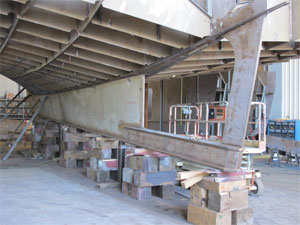 |
|
The keel is a key element of a W&D design. Putting the deepest part well aft improves lateral stability and assures good handling. |
“The intent was to sell it (the spec boat) and split the profits, if there were any,” he said.
Initially both Washburn and Doughty kept their jobs at BIW and worked on the fishing boat nights and weekends. Washburn developed the design. Much of the steel was scrap bought cheaply from BIW (leftover pieces too small for the big yard to use in its ships). The welding equipment came from Doughty’s garage.
As it turned out, their success did not hinge on the sale of the spec boat. In response to a “for sale” ad for the spec boat, they were approached by a man by the name of Dick Goodwin from Rhode Island. He liked the work they had done on the spec boat but wanted a larger vessel. He had plans for an 86-foot dragger and contracted Washburn and Doughty to build two of them. According to Washburn, he made a name for himself in the fishing industry by developing the first successful offshore freezer trawler on the East Coast. Subsequently, Goodwin had the yard build two freezer trawlers for his company, Sea Freeze, which became the first successful East Coast offshore freezing operation.
So they were on their way. Their order book came to include lobster boats (an obvious choice given their location along Maine’s rocky mid-coast region), a dinner cruise boat and some ferries. The first tug, Alice Winslow, Hull No. 39, came in the early ’90s. Like almost all of W&D’s towing vessels, this was a docking tug.
The next tug was Hull No. 64, Fort Bragg, built for Cape Fear Towing in North Carolina. Initially this was to be a conventional tug, but during the bidding stage a decision was made to equip the boat with z-drives.
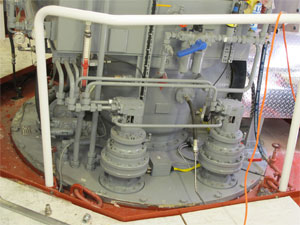 |
|
A Schottel z-drive aboard the escort and docking tug Apollo. |
Washburn’s in-house design skills proved invaluable. “We had to modify it significantly,” he recalled. The change involved “hanging 20 to 40 tons off the end of the boat. It’s like taking the reduction gear and moving it from the middle to the back end.”
Fort Bragg was delivered in 1997. The hull design became the model for the yard’s signature boats — 92-foot ASD docking tugs.
Washburn had come up with a design that was compact, maneuverable, stable, had a moderate draft and was quick (for a tug) while making only a moderate wake. Customers for the 92s included Moran, Seabulk Towing, Boston Towing and Marine Towing of Tampa. By Washburn’s count, W&D has built 22 of these boats.
When Fort Bragg was designed, its mission was pretty much limited to docking ships. Today, however, most tug operators are looking for more versatility. In response to the demands of their customers, tug operators want their docking tugs to have substantial escort capabilities as well.
“A new function was coming into play, escorting,” he said.
That means the ability to control a ship while moving at high speeds.
“That requires kind of dragging the boat sideways behind the ship,” he explained. “If you’re going to get dragged sideways, you’re going to need a lot of stability.”
To increase a tug’s escorting capabilities, designers usually add more vertical underwater surface area to the forward part of the boat to resist the forces pulling the tug sideways. “A lot of designers put the keel in the front of the boat to shift this area forward,” Washburn explained.
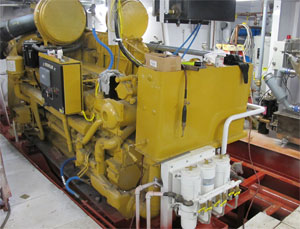 |
|
One of the tug’s two Cat 3516B diesels that generate 2,682 hp each. Apollo and a sister vessel, Athena, were delivered this year. |
While this approach boosts escorting ability, it creates some other issues. When prop wash from the escorted ship flows against the tug’s hull, the keel acts like a rudder on the front of the boat. That can hurt the tug’s handling characteristics.
“It’s kind of like putting the fat guy in the front of the boat when you are trying to steer a straight course,” he said.
Washburn has come up with a design that strikes a balance between docking ability and escort capability. The W&D design brings the deepest part of the keel farther aft. “That’s what leads to directional stability,” he said.
The effect is to increase lateral stability during escorts while maintaining more conventional handling characteristics.
The W&D keel design incorporates a practical element to simplify dry-docking. A boat with a keel-forward design would need to have a cradle to support the stern when dry-docked. The W&D design includes a keel extender that can support the weight of the boat almost all the way to the stern, eliminating the need for a dry-dock cradle.
The demands for escorting capabilities are typically quite specific. “When (tug operators) go for contracts, shipowners will say, ‘I want 200 tons of escorting ability,’” Washburn said.
To demonstrate to prospective customers that its tugs would meet those criteria, W&D asked Glosten Associates, a naval architecture and engineering firm in Seattle, to do computer simulations to evaluate the performance of the W&D hull design. Those simulations were used to establish the steering and braking power of two 98-footers that were delivered in 2006, Crescent Towing’s Bulldog and Moran’s Edward J. Moran.
“Based on the Glosten simulation, these boats have proven escorting forces, both steering and braking, comparable to some of the larger tugs,” Washburn said.
While paying close attention to power and performance, Washburn has not forgotten crew comfort and safety.
“We’ve tried to do a boat that has good seakeeping,” he said.
“Any tug will crank up a good bow wave,” he said. “Spray on the windshield is one thing. Water running down the deck is another.”
While water coming up over the bulwark may mostly be a comfort issue, when the tug is used for transferring a pilot to or from a ship, it becomes a safety issue.
“I like to have a fairly steep deadrise in the forward portion and a decent amount of flare in the topside,” he said. Over a career spanning four decades involving everything from naval combatants to small ferries, Washburn has seen enormous changes in the industry and the way boats are designed and built. The goal remains to produce “a high-quality product at a competitive price,” he said. “We’re fortunate to find customers who have that same philosophy. They want a quality boat.”
And Washburn is proud to design it.

